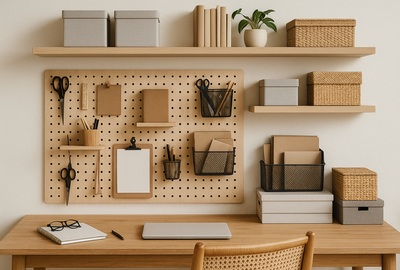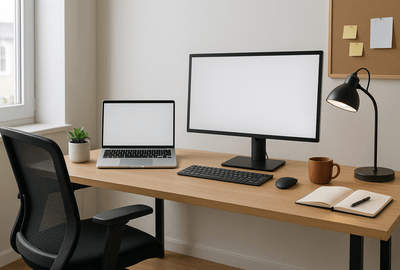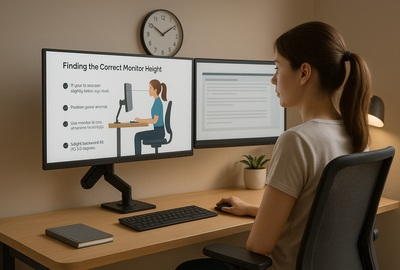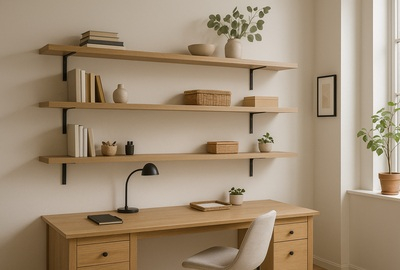- The Ideal Monitor Height: Ergonomic Tips for Work Comfort
- 1. Finding the Correct Height for Your Monitor
- 2. Practical Ergonomic Setup Tips for Adjusting Monitor Height
- 3. Influences on Ideal Positioning for Your Computer Screen
- 4. Common Monitor Placement Mistakes in Dual Monitor Setups
- 5. Adapting the Correct Monitor Setup for Different Workflows
- 6. Best Height and Distance for Eye Comfort at Your Computer Monitor
- 7. Tools to Adjust Monitor Arms and Confirm Ideal Position
- 8. Time to Fix Your Workspace with the Correct Monitor Placement
How High Should Your Monitor Be? Ergonomic Tips for Setup
Most office workers don’t think twice about their monitor setup—until the neck pain kicks in. We’re talking about that persistent tightness that creeps in after a full day staring at a screen. The reality? Your computer screen setup can either support good posture or slowly sabotage your spine.
With so many people working from home or shifting between hybrid setups, the way you position your screen plays a massive role in how your body feels by the end of the day. A poor setup might not feel like a big deal at first—but give it a few weeks, and your back, neck, and eyes will definitely disagree.
So, how high should your monitor be to keep you comfortable, productive, and pain-free? Let’s break it down with hard-earned insights, practical tips, and ergonomic logic that actually works in the real world—whether you’re at home, in the office, or somewhere in between.
1. Finding the Correct Height for Your Monitor
Let’s start with what proper monitor height actually looks like. In a seated position, your line of sight should land monitor slightly below eye level—roughly 5 to 10 cm from the top of your screen. This helps keep your neck in a neutral position and your shoulders relaxed, reducing strain over time.
When you're not having to adjust your head constantly to see your monitor, your entire upper body benefits. Think of it like alignment in a car—when everything lines up, there’s less wear and tear.
- Your main monitor should be at the correct height so you can view the entire screen without leaning forward.
- Position your monitor at an ideal distance—typically arm's length—for optimal viewing angle and minimal fatigue.
- A slight backward tilt of the screen can help align your gaze more naturally and reduce glare from overhead lighting.
- This small adjustment ensures the screen stays at the proper height, preventing long-term stress.
Key factors in your setup—like screen height, distance, and tilt—can dramatically influence your daily comfort and focus.
2. Practical Ergonomic Setup Tips for Adjusting Monitor Height
An ergonomic setup isn’t just one component—it’s how your screen, seating, and desk work together. You could have the best chair in the world, but if your monitor is off, you’ll still feel it by midday.
- Keep your feet flat on the floor or on a footrest.
- Your elbows should form a 90-degree angle; wrists should remain straight.
- Use monitor stands to make adjusting monitor height quick and effortless.
The easier adjusting monitor height is, the more likely you are to do it—preventing small misalignments from turning into long-term strain. Pair your screen with a supportive ergonomic chair. If you're frequently shifting between seated and standing positions, flexibility in your setup becomes even more important.
Improper monitor positioning while standing often leads to poor posture and chronic fatigue. Getting it right means less tension in your back, shoulders, and even your jaw—yes, posture affects that too.
3. Influences on Ideal Positioning for Your Computer Screen
Not all workspaces are created equal. The dining table? Not ideal. A fixed-height desk with a bulky monitor? Also problematic. Little things like furniture type, screen size, and even lighting can drastically influence how you view your screen.
Ignoring these factors can create a ripple effect of discomfort. Over time, you'll notice more than just soreness—your energy, focus, and mood might start to dip too.
- Low tables often result in a poor angle.
- The type and size of your computer monitor can shift your line of sight.
- Consider positioning the monitor away from direct light sources to screen properly.
A mismatch in desk height is one of the most overlooked causes of muscle strain when working long hours.
4. Common Monitor Placement Mistakes in Dual Monitor Setups
We’ve all seen it: one monitor too low, the other too far. Or worse, both crammed at awkward angles. With more people using multiple monitors today, alignment errors are becoming more common—and more harmful.
Incorrect positioning isn't just a comfort issue—it’s a performance issue. When your screens are out of sync, you're less efficient, and your body compensates in ways it shouldn’t.
- Mismatched screen positioning causes inconsistent angles and visual strain.
- In a dual monitor or multi monitor setups, both screens should be the same height and slightly curved toward you.
- Improper placement of your primary monitor or secondary monitor may lead to neck strain and shoulder strain.
Whether you're using a single monitor or a multi-screen layout, incorrect height can lead to compounding neck and shoulder tension over time.
5. Adapting the Correct Monitor Setup for Different Workflows
Your job influences your screen habits more than you realize. Writers stare straight ahead, designers shift left to right, and developers often split attention across multiple displays.
- Organize desk space for clean screen positioning.
- Make further adjustments based on your daily workflow.
- Customer service reps juggle multiple screens all day long.
- For two monitors, align both with your keyboard—not your desk edges—for proper ergonomics.
The more fluid your setup, the less you have to physically shift. That leads to more comfort and less fatigue, especially during deadline-heavy days.
6. Best Height and Distance for Eye Comfort at Your Computer Monitor
Vision strain is a subtle but serious consequence of poor screen positioning. If your eyes are dry, your focus is off, or your head feels heavy, your screen may be to blame.
- Ensure a proper distance and viewing distance to prevent squinting or dry eyes.
- Even a few centimeters off in monitor position affects comfort.
- Use the 20-20-20 rule to refresh your vision over extended periods.
Screen misalignment doesn’t just blur your vision—it builds up eye fatigue and contributes to chronic eye strain throughout the day.
If you're constantly adjusting your gaze, you're likely facing improper monitor height. This not only affects your eyes but your entire flow and ability to focus.
7. Tools to Adjust Monitor Arms and Confirm Ideal Position
Having the right tools on hand makes monitor setup faster, more accurate, and easier to tweak over time—especially if you’re using a shared desk or moving between sitting and standing. Here are a few essentials to help you dial in your setup:
- Monitor arms give you vertical and horizontal adjustment in any workspace, letting you position your screen precisely at eye level without taking up desk space.
- Use a level or ruler to check your monitor alignment. Your eyes should meet the top third of the screen without tilting your head.
- Ensure a clean horizontal line from your eye to the top edge of the monitor. This prevents neck strain caused by looking up or down for extended periods.
- Laptop risers and external input tools are crucial for mobile or hybrid workers. They raise the screen and let you maintain proper posture while typing.
Tools like these make setup and adjustment easy, which means fewer excuses and more consistency. They help you stay aligned even if you change positions or move between spaces often. This setup pays off—especially if you’re at your screen for long periods. Small improvements add up over the course of weeks and months.
8. Time to Fix Your Workspace with the Correct Monitor Placement
If you're still unsure whether your monitor is at the right height, ask yourself the following. These checkpoints will help you identify problem areas in your current layout:
- Can you view the entire screen without moving your head?
- Is your layout supporting workspace ergonomics?
- Are your screen heights aligned across all monitors?
- Does your workspace setup allow you to stay focused and comfortable for long sessions?
- Are you doing everything you can to avoid neck pain during the workday?
Dialing in these elements now saves you from discomfort later—and helps you build a more productive workspace that supports both focus and well-being. It’s not about perfection—it’s about making practical, sustainable tweaks that support your body and workflow. The right monitor height isn’t just a comfort decision—it’s a health investment.
Need help dialing in your setup? Deskup offers everything from standing desks to monitor arms—ready to help you build a smarter, safer workspace in minutes.


 Buy Now, Pay Later
Buy Now, Pay Later Verified Rating
Verified Rating 




